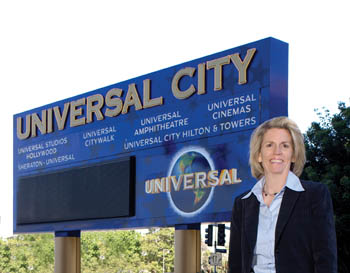
Lauren R. Bailey, CPCU, is the head of the entertainment unit for Fireman’s Fund.
Insuring the blockbusters
The entertainment unit of Fireman's Fund writes coverage for Hollywood's big hits
By Phil Zinkewicz
 |
Lauren R. Bailey, CPCU, is the head of the entertainment unit for Fireman’s Fund. |
When the Big Night finally arrived on February 27, members of the film industry gathered at the Kodak Pavilion in Los Angeles for the annual ritual that we have come to know as the Academy Awards, or Oscar Ceremony. First there was the traditional walk along the red carpet, during which actresses paraded their avant garde gowns and sometimes gaudy jewelry. Male actors sported tuxedos that were tuxedos in name only, and reporters from the entertainment and fashion fields shoved microphones into the plastic, smiling faces of nominees to elicit bland remarks about how they were feeling that night, as if they were feeling anything but sheer terror.
For actors, directors, producers, writers, composers and technical talent, a lot rides on that night. An Oscar can mean that an actor’s failing career will be turned around, that a director will be able to raise the money for that next project or that a producer will see box office success to warm the cockles of the hearts of anxious investors.
But for the Novato, California-based Fireman’s Fund’s entertainment unit, there was no tension at all. Fireman’s Fund was a shoe-in that night because, no matter what movie won the Oscar for best film—The Aviator, Finding Neverland, Million Dollar Baby, Ray or Sideways—the winning production had already been insured by Fireman’s Fund.
“That’s not surprising,” says Lauren Bailey, head of the entertainment unit for Fireman’s Fund. “In fact, we had provided insurance coverage for 16 contending films, which together garnered 61 of the 113 nominations in all categories. Our insureds captured all five nominations for best film, best lead actor and best supporting actor as well as four out of five for best director and best supporting actress.”
 |
Pictured from left are Entertainment Claims Manager Denise K. Dimin, AIC, and Underwriting Manager Suzy Wozniak. |
Bailey says that Fireman’s Fund is the premier international insurer for the entertainment arena, particularly the motion picture industry. “Without insurance, motion pictures as we know them today would be impossible to make, especially when a simple loss could easily cost upwards of $500,000 a day,” she says. “Fireman’s Fund is comfortable with that kind of risk because we’ve been the top insurer of the entertainment industry since the days of the silent screen. Back in those days, all that Hollywood needed was protection against fire damage to sets and props. Today, we provide a full range of sophisticated insurance protection, including the latest in special effects for a modern blockbuster.”
Bailey and Fireman’s Fund Underwriting Manager Suzy Wozniak say that, despite the glitz and glamour associated with Hollywood, this type of coverage is run strictly according to the business principles of any other line of insurance, and both had significant experience in the traditional property and casualty insurance industry before entering the entertainment insurance world. However, they admit that entertainment insurers often need to display flexibility and imagination in determining how to control loss and hedge risk.
Rats, corn, and more
For example, they say, in the classic Indiana Jones and the Last Crusade, hero Harrison Ford found himself in a catacomb crawling with rats, about 2,000 of them. “Few people realize that such a scene is always reviewed in concept by underwriters before the film begins production,” says Bailey. “The producer wanted to know whether Fireman’s Fund would pay for the delay in filming if something happened to the rats before the scene was shot. Since a day’s filming can easily run to between $200,000 and $700,000 in costs—location, actors, extras, equipment, buildings, etc.—Fireman’s Fund underwriters asked the producer how many rats they could lose and still film a reasonable scene. The director believed that camera angles could be used to work with as few as 1,000 rats. With that, we wrote the world’s first insurance policy with a 1,000-rat deductible.”
In the film Field of Dreams, a cornfield was the center of the action. Says Bailey: “Unfortunately, 1988 brought a terrible drought to the Midwest. So little rain fell in Iowa that the corn that was needed to fill up the field was threatened. Unless something was done, the film might even have to be canceled, which would prompt a major payoff.”
Here’s where the insurer’s underwriters’ imagination and flexibility came into play. Fireman’s Fund paid $200,000 to install an irrigation system in the cornfield so that corn could grow as high as the proverbial elephant’s eye. “We also dug a trench in front of the corn so that, when the actors stood in it, the corn appeared even higher,” says Bailey.
It’s not unusual for Fireman’s Fund to take a hand in controlling losses. For the New Line Cinema release of Pleasantville, the 1950s-era town was actually constructed in the parking lot of Malibu Creek State Park, in the Santa Monica Mountains of Los Angeles. Fireman’s Fund insured the entire set, which was valued at $6 million, against “all risks,” including brushfires, which are common in this mountainous terrain. However, underwriters required adequate brush clearance, water supply and access to the set before taking on the risk.
Wozniak says that the customary insurance needed on a movie production includes workers compensation, general liability and automobile insurance. There also are specialty coverages that protect producers against the costs associated with delays in producing a film and damage to the final product, she says. They include:
Cast coverage. The origins of this form of protection can be traced to a policy written on silver screen swashbuckler Douglas Fairbanks, Sr., insuring against any injury to his famous profile. Today, cast insurance can cover the extra costs to complete filming when cast and crew members are unavailable because of illness, injury or death. Cast coverage accounts for the highest volume of claim dollars paid, according to Wozniak. One notable example occurred when Sean Young, the leading lady in Batman, broke an arm 10 days before shooting was to begin. This coverage paid the extra salary and costuming required to hire a replacement leading lady with the same high box-office draw.
Props, wardrobe and set coverage. This covers the producer’s insurable interest in or legal liability for the value of props, sets, wardrobe and related equipment. For Star Trek, The Motion Picture, the Starship Enterprise—probably one of Hollywood’s most elaborate props—was insured for its full value against almost any imaginable peril under one of the biggest policies ever written, says Wozniak.
Extra expense coverage. This pays for the producer’s extra costs when filming is interrupted because property is damaged from an external cause. When a flash flood destroyed the western town built for the movie The Hallelujah Trail, prop coverage paid to rebuild the set while extra expense coverage paid for the lost time.
Third-party property damage coverage. This insures the production against damage during filming to property owned by a third party. For instance, say Wozniak, this coverage paid for damages to homes rented and accidentally ruined by the production company. In the film Thief, a home is burned up at the end. Unfortunately, a stray burning ember landed on a neighboring home and burned it to the ground. Fireman’s Fund paid $900,000 to replace the home and contents.
Miscellaneous equipment coverage. This protects against loss or damage to equipment such as cameras and lights and vehicles as well as legal liability resulting from their use. The coverage also applies to pilferage by souvenir hunters. Miscellaneous equipment coverage generates the largest number of smaller claims Fireman’s Fund has paid, says Wozniak.
Negative film coverage. This insures against theft of or damage to the film negative or the videotape equivalent. Most often claims are paid when the film is damaged in transit.
Faulty stock. This specialty coverage insures against extra costs incurred when film is damaged during shooting, processing or editing. Wozniak says a scene can be ruined when even a small scratch on a piece of film is magnified many times for the big screen. For instance, the movie Manhattan, starring Woody Allen, used the Metropolitan Museum of Art for a dinner party scene. Unfortunately, when developed, the film was not usable. Faulty stock insurance paid the producers to rent the museum a second time and re-shoot the scene.
In addition to these coverages, the entertainment industry also might seek other types of insurance. Errors and omissions liability coverage protects producers against lawsuits for libel or slander, defamation, theft of an idea, copyright or trademark infringement, violation of privacy and wrongful use of title. “In today’s litigious environment, such lawsuits are all too common,” says Bailey. “Also, many recording artists have been sued by musicians who claim the stars stole their songs. These stars are protected through insurance written with their recording studios or production companies or personal corporations. Even when the artists are found innocent of music infringement, these jury trials are time-consuming, complicated and costly,” she says.
Loss control is key
Obviously, Fireman’s Fund entertainment unit employees need to work closely with film production people when taking on a risk, and underwriters have to work closely with claims people. Denise Dimin, claims manager, and Sue Ann Howard, entertainment adjuster, have amassed a database of claims that have occurred over the years so that they can anticipate problem areas. “For potentially hazardous film situations, our loss control experts work with the directors and stunt coordinators, screening scripts for potential trouble and visiting movie sets, particularly when explosions are in the scenario,” says Dimin. “Our people do not censor or control a director. Instead, we work with directors to get exactly the shot they need with the least risk of injury to everyone concerned.”
Howard adds that although Fireman’s Fund has dedicated loss control people on hand to assess exposures, anything can happen. “In the film The Aviator, wildfires destroyed an airstrip that was being used for some scenes,” says Howard. “The claims not only included the damaged equipment, but also the downtime involved while looking for another airstrip that fit the period. In situations such as this, the cost of the damaged equipment is easily measured. Downtime is less predictable.”
Bailey says that premiums for coverage vary, but are usually between 1% and 5% of the total film budget. The entertainment unit writes business through a select group of brokers, and it can accommodate independent agents and brokers with entertainment risks that meet Fireman’s Fund’s criteria so long as they have an existing relationship with the company.
“Today’s new technologies are giving the motion picture business a makeover,” says Bailey. “Computer-generated imagery has reduced some of the risks involved in making a film. Bomb explosions or burning buildings can be created virtually, and even injured or deceased actors can be replaced with virtual alter egos. However, this doesn’t mean today’s film producers can go without insurance. In one respect, computer-generated imagery lessens risk, but it also increases other kinds of risks because we face more losses during post-production. There will no radical change for us in the near future.” *
For more information:
Fireman’s Fund Insurance Company
Web site: www.firemansfund.com
Phone: (800) 761-2024